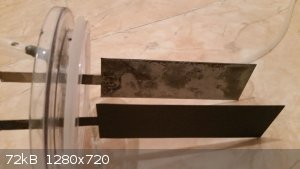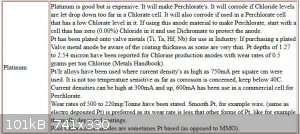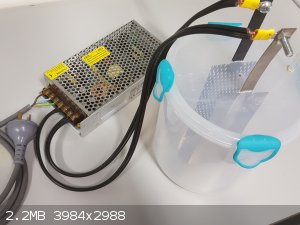| Pages:
1
..
3
4
5
6
7 |
greenlight
National Hazard
   
Posts: 763
Registered: 3-11-2014
Member Is Offline
Mood: Energetic
|
|
It should be Hydrogen coming from the vent tube in the cell.
I lead mine into a sodium hydroxide solution but never noticed any real bubbling.
What temperature is your cell running at?
I ran my 900ml cell for 100 hours total at 5 volt 20 amp and didn't notice any chlorate precipitating on the bottom for the first day or so.
The chlorine cell is normal and was present every time i opened my cell too.
|
|
|
ecos
Hazard to Others
  
Posts: 464
Registered: 6-3-2014
Member Is Offline
Mood: Learning !
|
|
Quote: Originally posted by greenlight  | It should be Hydrogen coming from the vent tube in the cell.
I lead mine into a sodium hydroxide solution but never noticed any real bubbling.
What temperature is your cell running at?
I ran my 900ml cell for 100 hours total at 5 volt 20 amp and didn't notice any chlorate precipitating on the bottom for the first day or so.
The chlorine cell is normal and was present every time i opened my cell too. |
Thanks Greenlight for your answer, I really appreciate it.
I checked my cell and it is hot but not sure about the temperature. I think it is around 40-60 degrees Celsius.
I use a PC power supply. I used the 5v terminal but noticed that the volts drops till 3.5v when it is connected to the cell. the current is 4A.
The power supply is capable to produce 20A on 5v but not sure why it drops down to 3.5v. 
what kind of power supply do you use?
two days of running and there is no sign of any KClO3 in the bottom. 
[Edited on 7-10-2015 by ecos]
|
|
|
greenlight
National Hazard
   
Posts: 763
Registered: 3-11-2014
Member Is Offline
Mood: Energetic
|
|
I never had a meter to see what voltage or amperage was running through the cell but mine did get hot to about 60 or 70 degrees. I had to use a water
bath at times because it would have gone higher.
I used this power supply:
http://www.ebay.com/itm/S-100-5-Super-Stable-Power-supply-un...
Have you been running the cell non-stop or have you let it cool down to see if an chlorate precipitates when the temperature drops back down?
|
|
|
hyfalcon
International Hazard
    
Posts: 1003
Registered: 29-3-2012
Member Is Offline
Mood: No Mood
|
|
If you are using potassium salts in a concentrated solution to start, you won't have to cool the electrolyte down. Due to it's lower solubility, the
potassium chlorate starts falling out of solution on it's own.
|
|
|
greenlight
National Hazard
   
Posts: 763
Registered: 3-11-2014
Member Is Offline
Mood: Energetic
|
|
Yes, my cell precipitated chlorate after the first day but when I cooled it down to room temp even more fell out of the solution.
Is it possible that Ecos does have chlorate but so little at the moment that it is staying dissolved while he is running the cell because of the
temperature of the electrolyte.
|
|
|
ecos
Hazard to Others
  
Posts: 464
Registered: 6-3-2014
Member Is Offline
Mood: Learning !
|
|
I didnt stop the cell to check the chlorate.
I only had power outage for several hours.would this destroy the chlorate formation?
I cant see any participation in the bottom of the cell and it is running for 3 days. 
|
|
|
greenlight
National Hazard
   
Posts: 763
Registered: 3-11-2014
Member Is Offline
Mood: Energetic
|
|
That shouldn't make a difference as far as I know.
I ran my cell in 20 hour intervals with a 4 hour rest every day and had no problems.
Only difference was my cell was 900ml and I used MMO anode and Titanium cathode with 5 volt 20 amp power supply.
Maybe yours is taking longer to form chlorate because of lower current through the cell and you have a much larger cell (2.5L if I am correct).
|
|
|
ecos
Hazard to Others
  
Posts: 464
Registered: 6-3-2014
Member Is Offline
Mood: Learning !
|
|
I stopped the circuit now. it looks really ugly and very yellow.
I noticed a lot of yellow particles in the bottom of the cell. I identified they are metal because they could be attracted to magnet ! , seems there
is erosion to my electrodes  . .

why the titanium cathode goes dark like this ?
No participation at all for any chlorate ! it is very weird and I am going crazy !
|
|
|
greenlight
National Hazard
   
Posts: 763
Registered: 3-11-2014
Member Is Offline
Mood: Energetic
|
|
That is really weird.
My titanium cathode went dark too but that hasn't affected further runs, I just wash it in dilute HCI before use.
|
|
|
specialactivitieSK
Hazard to Self
 
Posts: 94
Registered: 21-10-2014
Member Is Offline
Mood: No Mood
|
|
It is possible by this process to produce copper perchlorate ?
|
|
|
ecos
Hazard to Others
  
Posts: 464
Registered: 6-3-2014
Member Is Offline
Mood: Learning !
|
|
Finally it works. I got some chlorate and I burned it with some sugar and it glow 

The connection from the PC power supply to the electrodes were bad and caused voltage drop on each terminal (around 0.8 v) , I also noticed the
resistance of the titanium cathode is so high compared to the MMO anode and this also caused voltage drop which made the voltage in the electrolyte
very small (< 3v) I think this was the problem.
I used large steel bolt as cathode and fixed the connections between the power supply and the electrode and I started to notice the KClO3 appearing in
the second day.
I found some videos on internet on howto make MnO2 anode for chlorate cells : https://www.youtube.com/watch?v=nvMVlhBmv7M
They use Titanium as substrate , is it possible to use SS as substrate instead of Ti ?
[Edited on 14-10-2015 by ecos]
|
|
|
greenlight
National Hazard
   
Posts: 763
Registered: 3-11-2014
Member Is Offline
Mood: Energetic
|
|
Nice to see you got it worked out Ecos...
I finally got everything set up for a perc cell except for the electrodes.
Will one of these platinum coated titanium anodes work or should I wait and fork out the extra money for a lead dioxide one:
http://www.ebay.com/itm/PLATINIZED-TITANIUM-ANODE-PLATING-AN...
Also, for a cathode, can I use straight titanium electrode or do I have to use stainless steel?
|
|
|
hyfalcon
International Hazard
    
Posts: 1003
Registered: 29-3-2012
Member Is Offline
Mood: No Mood
|
|
That should do fine greenlight. I wouldn't let any of my electrodes sit in electrolyte without power running through them.
Titanium is actually the better the the two.
[Edited on 23-10-2015 by hyfalcon]
|
|
|
ecos
Hazard to Others
  
Posts: 464
Registered: 6-3-2014
Member Is Offline
Mood: Learning !
|
|
As a cathode it is not a problem to use any kind of electrode. SS or Titanium would give almost the same result.
per my experience, SS has better conductivity and this will reduce the voltage loss on it. It also cheap compared to titanium.
after doing the electrolysis you will find a dark layer on the cathode which has high resistance. You would need to remove it with HCl or sandpaper
for the next round. This would mean losing of the cathode weight by time.
below is the picture of my cathode (it was pretty shinning before, but looks ugly after electrolysis). I used sandpaper to clean it.
My advice :
1-use TWO SS bolts on each side of the anode. this will generate gasses on each side of the anode rather than one side.
2-save the titanium and plate it with MnO2 or PbO2 (I prepare a thread for this but still needs time). you would be able to use it as anode for
another cell.
Try to report the current and results  I am waiting for it I am waiting for it 

[Edited on 23-10-2015 by ecos]
|
|
|
greenlight
National Hazard
   
Posts: 763
Registered: 3-11-2014
Member Is Offline
Mood: Energetic
|
|
Thanks guys, I will run it with that Pt coated anode and a titanium cathode and post results and specs when finished.
|
|
|
greenlight
National Hazard
   
Posts: 763
Registered: 3-11-2014
Member Is Offline
Mood: Energetic
|
|
I have some experience with making potassium chlorate via electrolysis now and I am ready to attempt a perchlorate cell.
I have a 5v 20 amp power supply from making chlorate and a 5v 40 amp unused power supply. I think I will use the 20 amp power unit as I am only going
to use a 1 litre container for the cell as a test unit.
So just to check before I start the cell up:
1# I charge the cell with saturated sodium chloride solution and begin electrolysis with MMO anode and Ti cathode.
2# After the amount of time running that usually gets me a yield of chlorate for this size cell, I change the anode to the platinized one and begin
checking samples of the electrolyte with methylene blue for signs of perchlorate.
3# Try and estimate time to near completion using calculations from the various webpages on chlorate and perc manufacture.
4# Double decomp with potassium chloride solution and then recrystallise and wash product until no sign of chlorate left.
Does this sound right?
All help much appreciated
|
|
|
ecos
Hazard to Others
  
Posts: 464
Registered: 6-3-2014
Member Is Offline
Mood: Learning !
|
|
Hi Greenlight,
I don't think there is a need to use two electrode, the Pt is enough
you can check this video for deep details : https://www.youtube.com/watch?v=O1aWzrRBMjk
why don't u use two cells together, one for chlorate and the other for perchlorate ?
|
|
|
greenlight
National Hazard
   
Posts: 763
Registered: 3-11-2014
Member Is Offline
Mood: Energetic
|
|
Hey ecos,
I didnt mean use two electrodes, I mean use the MMO anode and titanium cathode and then when the sodium chlorate levels get high I will swap the MMO
for the Pt coated anode...
Then it will just have Pt anode and titanium cathode.
I will check the video out when I get home tonight
|
|
|
ecos
Hazard to Others
  
Posts: 464
Registered: 6-3-2014
Member Is Offline
Mood: Learning !
|
|
I totally understand you.
but why to use MMO then Pt if you can use Pt only by converting from NaCl to NaClO4 directly?
hmm let me guess, is it due to that perchlorate will not form till chlorate reach a certain level which is low enough to destroy your Pt anode?
if yes, you can use Pt to get chlorate with certain level then filter them out and use the chlorate to get perchlorate!
it was hard in my cell to change the anode since I used epoxy to fix it.
you will find some basic things that you didn't mention in your steps : 1) boiling water to get over saturated solution .... blah blah
|
|
|
greenlight
National Hazard
   
Posts: 763
Registered: 3-11-2014
Member Is Offline
Mood: Energetic
|
|
I thought the least I could use the platinized anode the better in terms of reducing wear on it.
I have heard high chloride levels are hard on it.
I want to go from NaCl to NaClo3 and finally NaCl04 before double decomposition with KCl.
And yes, I forgot to add some small steps like the boiling to attain a saturated solution but I do do that every time I charge the cell electrolyte
for my chlorate cell
|
|
|
yobbo II
National Hazard
   
Posts: 777
Registered: 28-3-2016
Member Is Offline
Mood: No Mood
|
|
It's SMALL chloride levels that are hard on the Pt anode.
|
|
|
ecos
Hazard to Others
  
Posts: 464
Registered: 6-3-2014
Member Is Offline
Mood: Learning !
|
|
Ref : http://www.oocities.org/capecanaveral/campus/5361/chlorate/a...

I and yaboo are right , for low levels not high levels !
|
|
|
greenlight
National Hazard
   
Posts: 763
Registered: 3-11-2014
Member Is Offline
Mood: Energetic
|
|
Whoops, regardless I still want to start with the MMO and then switch over after near conpletion to chlorate.
I am cleaning my titanium cathode in dilute Hcl today and wirebrushing off any buildup of crap on it. The MMO anode was just washed lightly as I
don't want to scrape any of the coating off. I am also looking for a larger container for the cell like 2 to 3 litres.
|
|
|
ecos
Hazard to Others
  
Posts: 464
Registered: 6-3-2014
Member Is Offline
Mood: Learning !
|
|
Good luck and looking forward for your result 
|
|
|
greenlight
National Hazard
   
Posts: 763
Registered: 3-11-2014
Member Is Offline
Mood: Energetic
|
|
I have finally got the cell finished after a few problems and it has been running for 2.5 hours now.
I am using a 2.25 litre container this time with a 5v 20 amp power supply.
The plan is to run the cell as a sodium chloride cell and convert most of the chloride to chlorate, then recharge the cell solution with sodium
chloride and electrolyze again then repeat a couple of times to build up the sodium chlorate concentration. Sodium chloride solubility in water is
something like 350g/L @ 25C and sodium chlorate is something around 700g/L @ 25C so once it is converted to chlorate, the cell can hold twice as much
dissolved in solution.
Then I will convert to sodium perchlorate with a Pt anode. I can either crystallize the sodium chlorate and start a new cell solution or put the
original cell solution straight into the perchlorate cell.
I have calculated the run time at 54% efficiency just to be safe and at my cell size it will take 43.80 hours to convert 86% chloride to chlorate. I
will run for 40 hours before recharging with sodium chloride again.
[Edited on 28-10-2016 by greenlight]

|
|
|
| Pages:
1
..
3
4
5
6
7 |